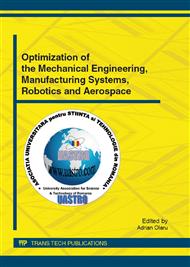p.176
p.182
p.188
p.194
p.200
p.208
p.214
p.221
p.227
The Preliminary Study of Machinability during Milling of Titanium Alloy (Ti-6Al-4V)
Abstract:
Titanium and its alloys have found wide application in the aerospace, biomedical and automotive industries owing to their good strength-to weight ratio and high corrosion resistance. However, these alloys have very poor machinability, which is attributed to their inherent high strength maintained at elevated temperature and low thermal conductivity leading to high cutting temperatures. This paper presents the findings of an experimental investigation into the effects of cutting speed, feed rate and depth of cut when milling titanium alloy Ti-6Al-4V. The cutting forces were the response variables investigated. This experimental investigation is translated into a mathematical model of cutting forces designed on the basis of the results obtained from this research.
Info:
Periodical:
Pages:
200-207
Citation:
Online since:
June 2012
Keywords:
Price:
Сopyright:
© 2012 Trans Tech Publications Ltd. All Rights Reserved
Share:
Citation:


